Yufeng Li
MDHP-Net: Detecting Injection Attacks on In-vehicle Network using Multi-Dimensional Hawkes Process and Temporal Model
Nov 15, 2024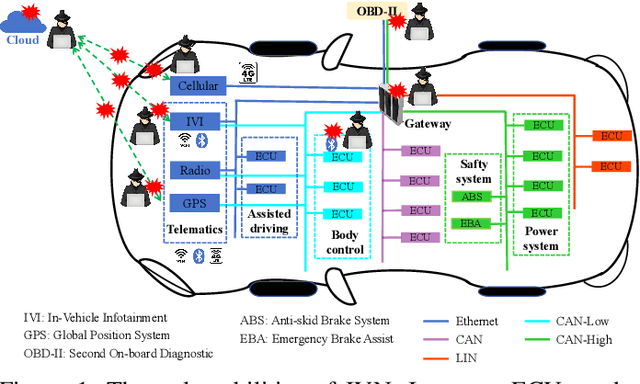

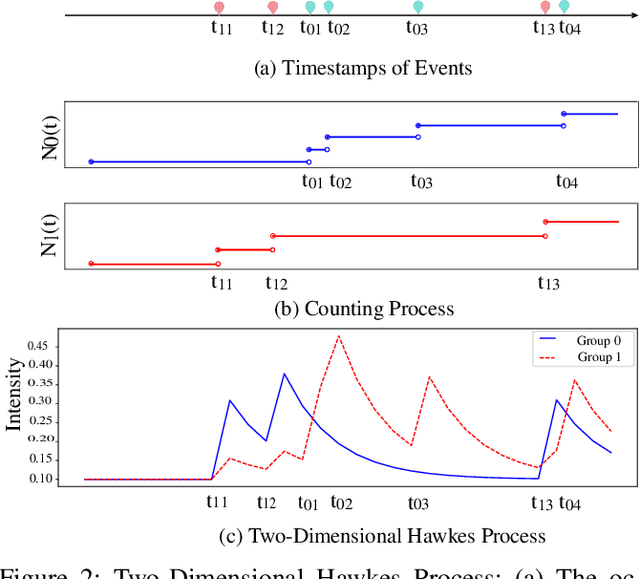
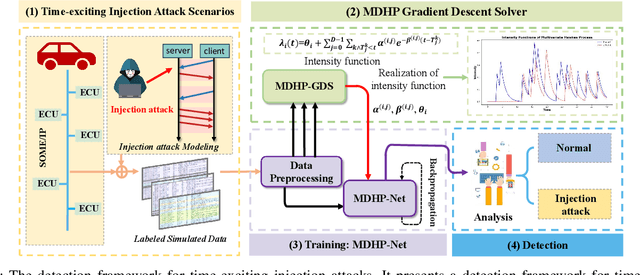
Abstract:The integration of intelligent and connected technologies in modern vehicles, while offering enhanced functionalities through Electronic Control Unit and interfaces like OBD-II and telematics, also exposes the vehicle's in-vehicle network (IVN) to potential cyberattacks. In this paper, we consider a specific type of cyberattack known as the injection attack. As demonstrated by empirical data from real-world cybersecurity adversarial competitions(available at https://mimic2024.xctf.org.cn/race/qwmimic2024 ), these injection attacks have excitation effect over time, gradually manipulating network traffic and disrupting the vehicle's normal functioning, ultimately compromising both its stability and safety. To profile the abnormal behavior of attackers, we propose a novel injection attack detector to extract long-term features of attack behavior. Specifically, we first provide a theoretical analysis of modeling the time-excitation effects of the attack using Multi-Dimensional Hawkes Process (MDHP). A gradient descent solver specifically tailored for MDHP, MDHP-GDS, is developed to accurately estimate optimal MDHP parameters. We then propose an injection attack detector, MDHP-Net, which integrates optimal MDHP parameters with MDHP-LSTM blocks to enhance temporal feature extraction. By introducing MDHP parameters, MDHP-Net captures complex temporal features that standard Long Short-Term Memory (LSTM) cannot, enriching temporal dependencies within our customized structure. Extensive evaluations demonstrate the effectiveness of our proposed detection approach.
KGV: Integrating Large Language Models with Knowledge Graphs for Cyber Threat Intelligence Credibility Assessment
Aug 15, 2024Abstract:Cyber threat intelligence is a critical tool that many organizations and individuals use to protect themselves from sophisticated, organized, persistent, and weaponized cyber attacks. However, few studies have focused on the quality assessment of threat intelligence provided by intelligence platforms, and this work still requires manual analysis by cybersecurity experts. In this paper, we propose a knowledge graph-based verifier, a novel Cyber Threat Intelligence (CTI) quality assessment framework that combines knowledge graphs and Large Language Models (LLMs). Our approach introduces LLMs to automatically extract OSCTI key claims to be verified and utilizes a knowledge graph consisting of paragraphs for fact-checking. This method differs from the traditional way of constructing complex knowledge graphs with entities as nodes. By constructing knowledge graphs with paragraphs as nodes and semantic similarity as edges, it effectively enhances the semantic understanding ability of the model and simplifies labeling requirements. Additionally, to fill the gap in the research field, we created and made public the first dataset for threat intelligence assessment from heterogeneous sources. To the best of our knowledge, this work is the first to create a dataset on threat intelligence reliability verification, providing a reference for future research. Experimental results show that KGV (Knowledge Graph Verifier) significantly improves the performance of LLMs in intelligence quality assessment. Compared with traditional methods, we reduce a large amount of data annotation while the model still exhibits strong reasoning capabilities. Finally, our method can achieve XXX accuracy in network threat assessment.
Research on Adverse Drug Reaction Prediction Model Combining Knowledge Graph Embedding and Deep Learning
Jul 27, 2024
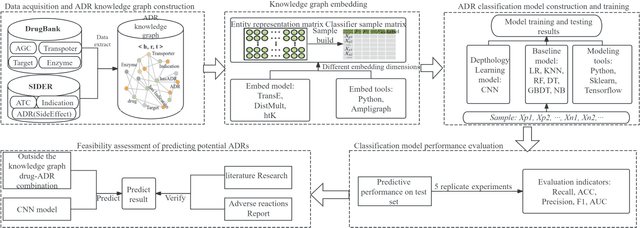
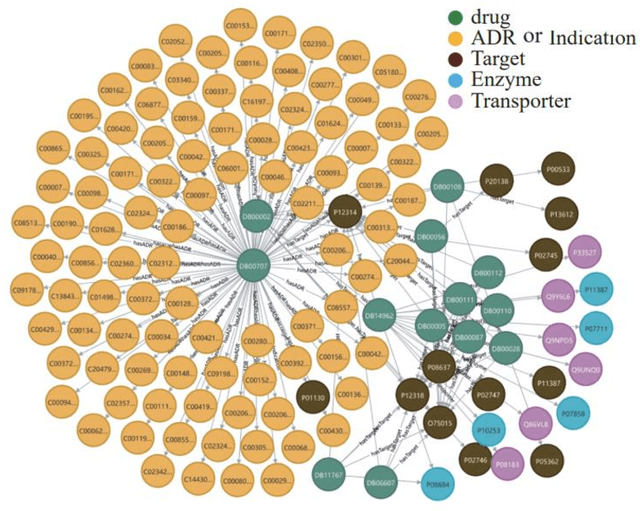

Abstract:In clinical treatment, identifying potential adverse reactions of drugs can help assist doctors in making medication decisions. In response to the problems in previous studies that features are high-dimensional and sparse, independent prediction models need to be constructed for each adverse reaction of drugs, and the prediction accuracy is low, this paper develops an adverse drug reaction prediction model based on knowledge graph embedding and deep learning, which can predict experimental results. Unified prediction of adverse drug reactions covered. Knowledge graph embedding technology can fuse the associated information between drugs and alleviate the shortcomings of high-dimensional sparsity in feature matrices, and the efficient training capabilities of deep learning can improve the prediction accuracy of the model. This article builds an adverse drug reaction knowledge graph based on drug feature data; by analyzing the embedding effect of the knowledge graph under different embedding strategies, the best embedding strategy is selected to obtain sample vectors; and then a convolutional neural network model is constructed to predict adverse reactions. The results show that under the DistMult embedding model and 400-dimensional embedding strategy, the convolutional neural network model has the best prediction effect; the average accuracy, F_1 score, recall rate and area under the curve of repeated experiments are better than the methods reported in the literature. The obtained prediction model has good prediction accuracy and stability, and can provide an effective reference for later safe medication guidance.
FactFinders at CheckThat! 2024: Refining Check-worthy Statement Detection with LLMs through Data Pruning
Jun 26, 2024Abstract:The rapid dissemination of information through social media and the Internet has posed a significant challenge for fact-checking, among others in identifying check-worthy claims that fact-checkers should pay attention to, i.e. filtering claims needing fact-checking from a large pool of sentences. This challenge has stressed the need to focus on determining the priority of claims, specifically which claims are worth to be fact-checked. Despite advancements in this area in recent years, the application of large language models (LLMs), such as GPT, has only recently drawn attention in studies. However, many open-source LLMs remain underexplored. Therefore, this study investigates the application of eight prominent open-source LLMs with fine-tuning and prompt engineering to identify check-worthy statements from political transcriptions. Further, we propose a two-step data pruning approach to automatically identify high-quality training data instances for effective learning. The efficiency of our approach is demonstrated through evaluations on the English language dataset as part of the check-worthiness estimation task of CheckThat! 2024. Further, the experiments conducted with data pruning demonstrate that competitive performance can be achieved with only about 44\% of the training data. Our team ranked first in the check-worthiness estimation task in the English language.
Technique Report of CVPR 2024 PBDL Challenges
Jun 15, 2024
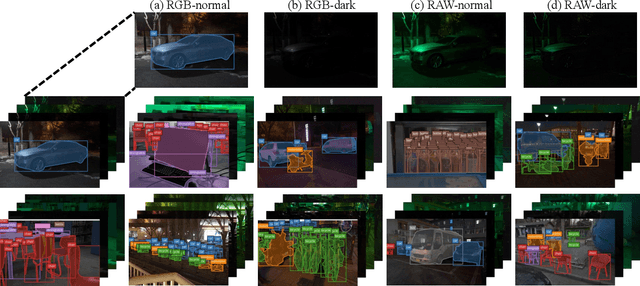
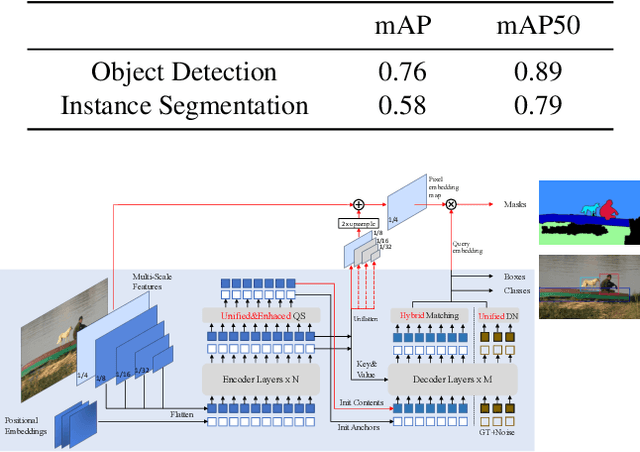

Abstract:The intersection of physics-based vision and deep learning presents an exciting frontier for advancing computer vision technologies. By leveraging the principles of physics to inform and enhance deep learning models, we can develop more robust and accurate vision systems. Physics-based vision aims to invert the processes to recover scene properties such as shape, reflectance, light distribution, and medium properties from images. In recent years, deep learning has shown promising improvements for various vision tasks, and when combined with physics-based vision, these approaches can enhance the robustness and accuracy of vision systems. This technical report summarizes the outcomes of the Physics-Based Vision Meets Deep Learning (PBDL) 2024 challenge, held in CVPR 2024 workshop. The challenge consisted of eight tracks, focusing on Low-Light Enhancement and Detection as well as High Dynamic Range (HDR) Imaging. This report details the objectives, methodologies, and results of each track, highlighting the top-performing solutions and their innovative approaches.
Real-Time Pill Identification for the Visually Impaired Using Deep Learning
May 08, 2024Abstract:The prevalence of mobile technology offers unique opportunities for addressing healthcare challenges, especially for individuals with visual impairments. This paper explores the development and implementation of a deep learning-based mobile application designed to assist blind and visually impaired individuals in real-time pill identification. Utilizing the YOLO framework, the application aims to accurately recognize and differentiate between various pill types through real-time image processing on mobile devices. The system incorporates Text-to- Speech (TTS) to provide immediate auditory feedback, enhancing usability and independence for visually impaired users. Our study evaluates the application's effectiveness in terms of detection accuracy and user experience, highlighting its potential to improve medication management and safety among the visually impaired community. Keywords-Deep Learning; YOLO Framework; Mobile Application; Visual Impairment; Pill Identification; Healthcare
Breast Cancer Image Classification Method Based on Deep Transfer Learning
Apr 14, 2024



Abstract:To address the issues of limited samples, time-consuming feature design, and low accuracy in detection and classification of breast cancer pathological images, a breast cancer image classification model algorithm combining deep learning and transfer learning is proposed. This algorithm is based on the DenseNet structure of deep neural networks, and constructs a network model by introducing attention mechanisms, and trains the enhanced dataset using multi-level transfer learning. Experimental results demonstrate that the algorithm achieves an efficiency of over 84.0\% in the test set, with a significantly improved classification accuracy compared to previous models, making it applicable to medical breast cancer detection tasks.
Convolutional neural network classification of cancer cytopathology images: taking breast cancer as an example
Apr 12, 2024



Abstract:Breast cancer is a relatively common cancer among gynecological cancers. Its diagnosis often relies on the pathology of cells in the lesion. The pathological diagnosis of breast cancer not only requires professionals and time, but also sometimes involves subjective judgment. To address the challenges of dependence on pathologists expertise and the time-consuming nature of achieving accurate breast pathological image classification, this paper introduces an approach utilizing convolutional neural networks (CNNs) for the rapid categorization of pathological images, aiming to enhance the efficiency of breast pathological image detection. And the approach enables the rapid and automatic classification of pathological images into benign and malignant groups. The methodology involves utilizing a convolutional neural network (CNN) model leveraging the Inceptionv3 architecture and transfer learning algorithm for extracting features from pathological images. Utilizing a neural network with fully connected layers and employing the SoftMax function for image classification. Additionally, the concept of image partitioning is introduced to handle high-resolution images. To achieve the ultimate classification outcome, the classification probabilities of each image block are aggregated using three algorithms: summation, product, and maximum. Experimental validation was conducted on the BreaKHis public dataset, resulting in accuracy rates surpassing 0.92 across all four magnification coefficients (40X, 100X, 200X, and 400X). It demonstrates that the proposed method effectively enhances the accuracy in classifying pathological images of breast cancer.
Survival Prediction Across Diverse Cancer Types Using Neural Networks
Apr 11, 2024Abstract:Gastric cancer and Colon adenocarcinoma represent widespread and challenging malignancies with high mortality rates and complex treatment landscapes. In response to the critical need for accurate prognosis in cancer patients, the medical community has embraced the 5-year survival rate as a vital metric for estimating patient outcomes. This study introduces a pioneering approach to enhance survival prediction models for gastric and Colon adenocarcinoma patients. Leveraging advanced image analysis techniques, we sliced whole slide images (WSI) of these cancers, extracting comprehensive features to capture nuanced tumor characteristics. Subsequently, we constructed patient-level graphs, encapsulating intricate spatial relationships within tumor tissues. These graphs served as inputs for a sophisticated 4-layer graph convolutional neural network (GCN), designed to exploit the inherent connectivity of the data for comprehensive analysis and prediction. By integrating patients' total survival time and survival status, we computed C-index values for gastric cancer and Colon adenocarcinoma, yielding 0.57 and 0.64, respectively. Significantly surpassing previous convolutional neural network models, these results underscore the efficacy of our approach in accurately predicting patient survival outcomes. This research holds profound implications for both the medical and AI communities, offering insights into cancer biology and progression while advancing personalized treatment strategies. Ultimately, our study represents a significant stride in leveraging AI-driven methodologies to revolutionize cancer prognosis and improve patient outcomes on a global scale.
REFRAME: Reflective Surface Real-Time Rendering for Mobile Devices
Mar 25, 2024Abstract:This work tackles the challenging task of achieving real-time novel view synthesis on various scenes, including highly reflective objects and unbounded outdoor scenes. Existing real-time rendering methods, especially those based on meshes, often have subpar performance in modeling surfaces with rich view-dependent appearances. Our key idea lies in leveraging meshes for rendering acceleration while incorporating a novel approach to parameterize view-dependent information. We decompose the color into diffuse and specular, and model the specular color in the reflected direction based on a neural environment map. Our experiments demonstrate that our method achieves comparable reconstruction quality for highly reflective surfaces compared to state-of-the-art offline methods, while also efficiently enabling real-time rendering on edge devices such as smartphones.
 Add to Chrome
Add to Chrome Add to Firefox
Add to Firefox Add to Edge
Add to Edge